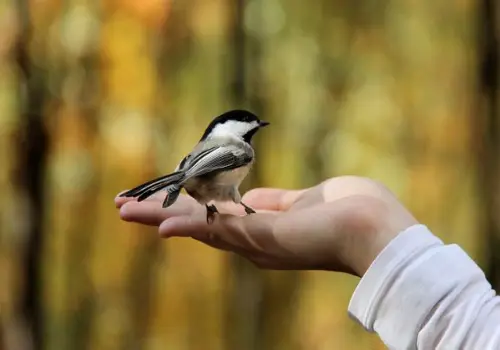Despite being comparably a diminutive region in the United States, Vermont won't disappoint any birder who seeks an excellent birdwatching experience within the area.
And I think…
With the vast fir-spruce woodlands and marshes throughout the state, you probably wonder what birds of Vermont you might chance upon in backyard bird feeders.
Birds are everywhere; the stunning wildlife surrounds us, and we must conserve it in the places where it exists.
Improving our Vermont bird identification skills is only the beginning of a long journey. Keep reading as we learn more about common backyard birds you can expect in the state.
The Most Familiar Backyard Birds in Vermont
Have you ever experienced hearing a bird chirp outside your window, not realizing what it was if not for the distinct "chicka-dee-dee-dee" sound it makes? Experienced birders will know that it is a black capped chickadee.
But beginners may not be able to identify a bird merely with its looks or if it's not chirping. Sometimes, even if you encounter a chirping bird, you will barely recognize it if you're not too familiar with its sounds.
Several people try to cut the chase, focusing more on different field marks based on feather color and pinning the name on a bird. But birding takes a lot more than that. Plumages are not the end-all and be-all in bird identification.
Discovering a new bird in your yard or observing a favorite bird are moments that many bird enthusiasts treasure. It enhances the overall experience if you effortlessly and confidently identify the common backyard birds in your area.
Aside from the field marks, you also pay attention to a bird's shape, if it's plump or slender, or if it has rounded or pointed wings. You may also observe its bill, tail., behavior, flight pattern, and habitats, as these are things that can make Vermont bird identification easier for you.
1. Black-Capped Chickadee
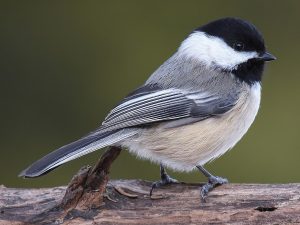
You can identify black-capped chickadees with their songs and calls. This chickadee is a small bird; its song is like a clear whistle of "fee-bee-ee." The first note of its music is higher, and its voice sounds like a clean "chick-a-dee-dee-dee."
Black-capped chickadees favor the woods, riparian thickets, shade trees, parks, and gardens, and they also love to visit bird feeders.
Along with many other birds, such species is widespread and regularly occur in the boreal forests of North America during migration, wintering, and breeding seasons. Although depending on a specific variation, most eastern chickadees are irruptive in winter.
These birds can lower their body temperatures in freezing weather. Further, chickadees have a vast vocal range, consisting of about fifteen songs and calls, throwing their voices when evading predators.
A black-capped chickadee has a unique black and white plumage, short black bill, black cap and bib, white-edged outer tail feathers, and faded bluff flanks. Its black head and grayish-brown parts are noticeable when in flight.
The bird is generally tame; you will likely encounter it in backyard feeders due to its strong affinity for sunflower seeds.
Most of us probably don’t see chickadees as mountainous creatures. Nonetheless, you can find such species on the mountaintops of Mount Mansfield in Vermont.
2. White-Breasted Nuthatch
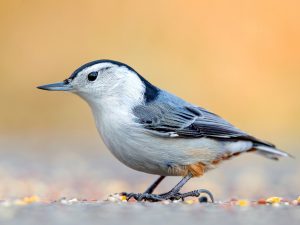
The white breasted nuthatch is a non-migratory species preferring habitats where trees are abundant, such as mixed and deciduous forests. A white breasted nuthatch displays a strong affinity for trees; it is least likely that you will find it away from woodlands, groves, and suburbs.
If you wish to attract such birds to your space, it's best to plant spruces, native oaks, pines, hickories, and maples.
It is among the backyard birds in Vermont, with pairs lingering in their territories throughout the year. Male white breasted nuthatches sing all winter to lure females into their territory.
It sings non-stop while displaying the plumage on his head as the female approaches; for nuthatches, the darker-colored napes make the males more attractive. If the female white breasted nuthatch stays close, courtship behavior may progress into courtship feeding.
Both male and female white breasted nuthatches have blue gray wings, a black cap, a white breast, and a diagonal black line near their eyes. The bird's voice is a nasal-sounding call; its song is a gentle rising tone, somewhat repetitive and fast.
Despite the geographic variation in the sounds of a white breasted nuthatch, many birders easily recognize its male and female yanks and twitters. The pairs often intimately converse as they forage.
Such a bird species prefer to nest in natural cavities and birdhouses, laying between five to ten white eggs with markings in various colors. White breasted nuthatches specialize in tree nuts, such as acorns and beechnuts, occasionally feeding on insects and larvae.
Nevertheless, black oil sunflower seeds, unsalted peanuts, hulled sunflower seeds, and beef suet are their favorites when visiting bird feeders.
3. House Finch
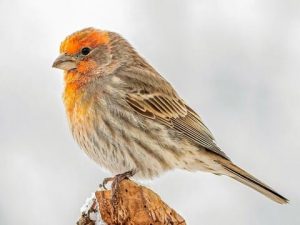
Some birds are well-adapted even to the most urban environments, like the cities. It is no longer unusual to see American robins hopping on lawns or house finches singing from ornamental trees.
The house finch is a native of the Southwestern region, imported to the east, and is now widespread across the United States.
House finches are familiar guests to backyard feeders, rearing their juveniles in urban and suburban areas. The bird sometimes nests on window sills, hanging baskets, and in garages. This friendly creature is among the birds in Vermont, inhabiting scrubby areas and open forests.
These are friendly birds commonly perching on treetops nearby when not exploiting bird feeders. Additionally, such a finch moves slow and stays still as it grinds seeds with quick nibbles; its backyard favorites are suet and black oil sunflower seeds.
Likewise, it enjoys feeding on seeds, weeds, leaf buds, and berries. With that in mind, you will have better chances of having these creatures grace your bird feeders if they find such food.
Aside from this finch, American goldfinches, tufted titmice, hoary and common redpolls are birds that do well in thriving on seeds during the colder months. The dark eyed juncos and pine siskins are also seed lovers, especially the tiny ones.
You can attract them, and maybe they will even stay longer in your space if you have seed-bearing plants and native patches of grasses. In winter, it might be challenging to lure one or two of these house finches if you have a small to medium-sized garden.
Nevertheless, providing a home for these feathered friends regardless of the season can do wonders in preserving their population. Many bird enthusiasts find it delightful to see this finch species in winter, showering under a dried-up sunflower with its wings whipping the snow.
The wings of these small birds are short, creating an illusion of elongated tails; they have relatively shallow-notched tails compared to other birds of their kind. Like the other finches, a house finch also has a bouncy flight, and it has a sizable bill, too.
You will recognize a house finch with its brown cap, reddish forehead, breast, and rump. However, that reddish shade is diet-related, varying from reddish-orange to a faintish mustard yellow. It also has dark brown streaks on its back, belly, and tail, with a stripe over its eye.
4. Blue Jay
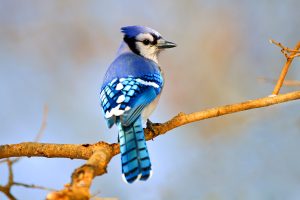
The Blue Jay is among the wild birds of Vermont most people are familiar with and is undoubtedly responsible for many people's interest in nature conservation.
You might notice how a blue jay would sometimes elbow its way to a table, grab a fruit and flee. Otherwise, the bird could be scouting under the table for chopped berries to feed its nestlings.
Besides blue jays, other birds, including American robins, starlings, and grackles, likewise display such under-the-table manners.
Like woodpeckers and nuthatches, blue jays display a strong affinity for oaks. You will probably see a blue jay with the red bellied woodpecker as they carry and cache acorns while the cedar waxwings feast on the buds.
Even migrating warblers benefit from the insects feasting on the oak's early blossoms, as most wild birds forage bugs from these oaks to feed their young.
The blue jay is a boisterous bird slightly sizable than an American robin, with a prominent crest and noticeable white markings on wings and tails. A blue jay has a flight and roadsides silhouettes, blue gray plumage with a black bib, and whitish to faint gray underparts.
There's a black mask between this jay's eye and bill; like its long bill, the legs and tails are also black with a black-barred tail. It's hard not to notice a blue jay's blue gray wings with a brownish tint and a bold white wing bar when in flight.
Moreover, blue jays are experts in imitating hawk calls to deceive other birds into thinking that a hawk is nearby. Such are fascinating common backyard birds, particularly their group dynamics, like the aerial courtship chase. Many bird lovers refer to its scream as an accurate winter sound.
It is well-known for the harsh screaming, a typical jay-like, squeaky-gate call with intense slurring, and many other notes. These jays prefer obscured nests made from twigs; females lay about four to five pale blue or greenish eggs with brown markings.
The bird is fond of breeding in coniferous or deciduous trees, feeding substantially on acorns, so they supplement such a diet with weevil larvae in winter. Nonetheless, these jays also eat insects, fruits, and seeds.
You will also see these attractive creatures in bird feeders, where the jays' dominant personalities are most noticeable. The jays sometimes bicker with the other birds for food when scarce; they also frequent city parks, woodlands, suburban gardens, and farmlands.
Aside from being an enthusiastic peanut eater and opportunistic omnivore, a blue jay is also a famous stasher. It forages food and stores it in crevices or other hiding places to retrieve for later.
5. Northern Cardinal
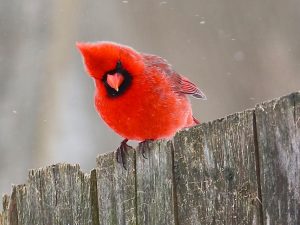
The northern cardinal is among the medium sized birds, smaller than American robins, with an elongated tail, short bill, and striking crest. Such a bird often sits hunched over with its tail pointed downwards; its bright red shade makes the cardinal a familiar sight.
Male northern cardinals have red plumage all over; even their bills are red, highlighted by a black mask surrounding them.
On the contrary, female cardinals have brown plumage with reddish hints on their wings, tails, and crests, with a black mask surrounding their red-orange beaks. Juveniles have no black shades on their faces, and they also lack the red bills of adults.
A northern cardinal often sits low in shrubberies and trees or is busy with ground foraging in pairs. The cardinals love to visit bird feeders but are mostly discreet away from them, so it will help to become familiar with their loud, metallic voices.
Additionally, a northern cardinal finds peanuts in the shell, millet, cracked corn, white proso, hulled, and black oil sunflower seeds irresistible.
Seeds are a cardinal's preferred diet in winter, while cicadas and beetles are their favorite meals in summer and will also eat fruit when available.
During early fall, a female cardinal finds berries on a sweetbay magnolia irresistible; such a plant is a rich source of lipids that brighten its feathers. Comparatively, the male gets his bright red plumage from native berries.
Such dietary carotenoid pigments in a bird's diet, like the northern cardinal, contribute to its ornamental color displays.
You will likely encounter a northern cardinal in Vermont woodlands with abundant thickets, shrubby forest edges, private backyards, and parks. Such a bird favors dense shrubberies and vines when creating its nest from twigs and grasses.
The extensive range of northern cardinals shows a significant increase from the Taconic Mountains to the Champlain Lowlands, Eastern Foothills, and throughout the east-central region.
Its breeding and winter ranges are comparable, suggesting that the northern cardinal is a non-migratory species.
Fun Fact: Despite its nature as a non-migratory bird, the Northern Cardinal could also be seen flocking around in Pennsylvania!
6. Downy Woodpecker
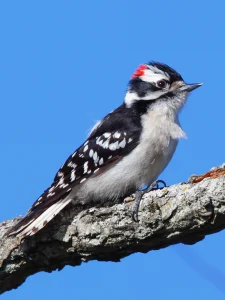
Similar-looking to the hairy woodpecker, downy woodpeckers are more familiar in Vermont backyards. If you wish to tell these two birds apart, look for their body size since the downy woodpecker is smaller than the hairy.
It is smaller than the red winged blackbird and about the same size as the white-crowned sparrow, but the downy's tail is shorter.
Hairy woodpeckers also have longer bills than the downy woodpeckers, despite being bewilderingly alike. Likewise, some of the identifiers for this creature are its black wings with a white checkered pattern and a red spot on the male's scruff.
On the other hand, the young downy woodpecker has that red spot on its crown. You can find these two birds in almost the same habitats, but the hairy woodpecker forages insects on tree trunks and larger branches.
Comparatively, the downy woodpecker searches for food on smaller branches, reducing the competition between the two similar-looking species. However, hairy woodpeckers are a more prevalent species during the colder months.
Generally, such woodpeckers are sedentary but often venture into unoccupied habitats during the breeding season, including backyard feeders from the end of summer through early spring.
To identify a downy woodpecker, look for its white back, black wings, short bill, and the black and white stripes on its face. You will have no trouble finding the Downies anywhere there are trees, except in the arid regions of the southwest.
Birders often spot this woodpecker in suburban gardens, city parks, open woodlands with abundant oaks and pines, and newly-burnt forests. Its foraging style includes probing tree trunk crevices and tirelessly looking for arthropod larvae in weed stems.
Despite that, the downy is one of the common birds that feed on fruit and nuts; suet and cracked sunflower seeds are its backyard favorites.
The courtship drumming of a downy woodpecker is often a welcome sign of spring after the frigid mornings of winter. But even if nesting for such woodpecker species won't begin until the springtime, its fast, sharp beats mean you can look forward to warmer days ahead.
7. Song Sparrow
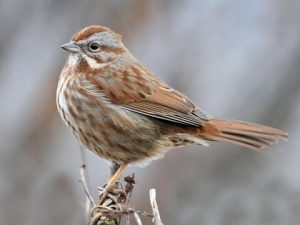
Backyards, parks, and shrubby environments throughout North America find comfort in the welcoming sound of a song sparrow's beautiful song. It is one of the most common backyard birds of all the Passerellidae, with various subspecies.
The song sparrow is among the North American songbirds with the most geographical variables.
Like some birds of its kind, these sparrows have long, rounded tails and shallow bellies and prefer to nest in dense vegetations near the ground.
In addition to brushy areas with an adjacent water source, gardens and yards are its favored breeding ground. Despite feeding on weed seeds, a significant part of this sparrow's diet includes insects, especially in summer.
Citizens of Vermont have observed that a female song sparrow will start building its nest sometime in early April. The female will begin laying its pale green to greenish-white eggs between May and August.
Further, song sparrows are common birds with mid-sized, stocky bodies. The bird has a short bill, rounded head, and relatively broad wings. You can distinguish Southern song sparrows with pale brown plumes, while the northern form has a dark brown shade and is more sizable.
Typically, a song sparrow doesn't mind foraging alone, or sometimes, it will join a small-sized flock. Chips and trills in different tones make up its song, and the bird calls with a "chip-chip-chip" in a low, nasal voice.
Each song sparrow has a unique dialect; you won't encounter such a bird of this species that sings the same tune. No one had a close encounter with this feathered creature that did not enjoy its energetic, joyous music, especially the male's sweet song with shorter notes.
Some would say that the varying plumages in song sparrows are due to melanin, making the feathers more resistant to decay-causing bacteria. Moreover, the faint-colored plumes in arid regions help these sparrows keep themselves discreet.
8. Gray Catbird
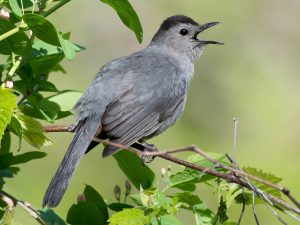
The gray catbird is one of the most beautiful common birds in Vermont. It might be a medium sized bird, but it certainly has a lot of character. Once you hear its feline-like calls, you will understand how the bird has its name.
Aside from its voice that resembles a cat's sound, gray catbirds are excellent imitators of other birds' songs.
Interestingly, a gray catbird's impressive vocal repertoire differs from relatives like thrashers and mockingbirds since it doesn't repeat its songs. This eye-catching songbird has a slender body, a narrow, pointed beak, a round-tipped, elongated tail, noticeable long legs, and broad wings.
Adult gray catbirds share the same look with their juveniles, sporting a slate-gray overall, dark gray to black tails, and rufous undertail coverts. Its sneaky behavior is why a gray catbird prefers to stay discreet in thickets near the ground while foraging seeds, berries, and insects.
So, don't be surprised if you notice how this beauty will sometimes take a peek from the foliage as it seemingly investigates its surroundings.
Despite such a bird's stealth movements, it remains to be energetic as it hops and flutters from one branch to another. Otherwise, you may encounter this catbird perching on a white spruce tree.
If you wish to spot a gray catbird successfully, dense shrubberies, small trees, lakefront thickets, and farmlands are the best places to look out for it.
It is also pretty impressive how such a bird can be well-adapted to the presence of humans. Hence, these catbirds frequent backyards in suburban and urban lots.
9. Red-Winged Blackbird
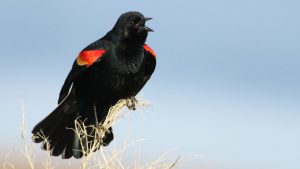
The red winged blackbird is one of Vermont's most prominent breeding birds, with quite an unfavorable reputation due to lost revenues because of damaged crops.
Together with the starlings, these blackbirds often wreak havoc on sweet corns, even the sprouting ones, which they pull out to feed on the seeds.
Aside from the blackbirds, the American crow, grackle, woodpecker, cowbird, and sapsucker also cause damage to fruit crops.
You can easily recognize red winged blackbirds with slender bodies, conical bills, and favorite classy look. Breeding males are well-known for their red and bright yellow shoulder badges that highlight their overall black plumage.
The song sparrow's subspecies from southern Alaska is about the size of a red winged blackbird. Females have fine streaks and deep brown overall, pale brown breasts, and often sport whitish eyebrows despite the sparrow-like appearance.
Contrarily, the young and non-breeding males have their feather edges in a scarlet shade and typically form huge flocks during such a season. These birds have loud, raspy, vibrating voices you will hear while they perch on top of high branches or swaying stems.
Blackbirds frequent agricultural areas with nearby water sources, meadows, and marshes but strongly favor dry upland areas, like the hayfields and pastures, when breeding.
The territorial males start arriving in Vermont halfway through March when you will mostly see them gathering with foraging flocks. Its territorial display fascinates many, which these blackbirds do by spreading their wings as they sing their intense, trisyllabic flight song.
These creatures also have a polygynous mating behavior, with females taking the lead in choosing their breeding location. Aside from the active display of territorial defense, male blackbirds use their epaulets to lure potential mates and warn their adversaries.
The handsome bird utilizes its mighty bill when foraging crunchy grasshoppers and crickets. Despite being a pest for some people for its love for berries, this blackbird's preference for wireworms, moths, and cutworms makes it beneficial to human populations.
10. House Sparrow
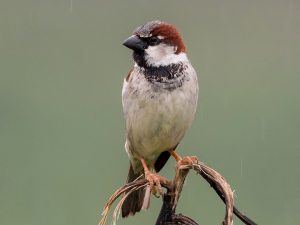
When people hear the name house sparrow, they sometimes think it's the well-known sparrows of the north. However, house sparrows belong to the Eurasian family, familiar to most birders as the weaver finches, and nowadays, has an undesirable reputation as invasive species.
Despite being a pest for many humans, this sparrow does a pretty good job of thriving in almost any kind of habitat. You can expect the bird to inhabit any environment except mountain peaks and deserts.
When it first came to the northern hemisphere, it wasn't as widespread as it is nowadays and is even one of the most common backyard birds.
You'll rarely see such a sparrow alone, as it is among the common birds that roost communally. Doing so makes such a sparrow feel less vulnerable to predator attacks.
It may resemble our native sparrows at some point, but the house sparrows have uneven body markings, broad tails, and thick beaks. These features can help you identify the house sparrow from the native sparrows of the north, regardless of their varying plumages.
An American sparrow is recognizable with the fine streaks on its black and brown plumes, while house sparrows have distinctive orange stripes on their backs.
Furthermore, the bird's loud chirping differs from its simple yet high musical notes. You can tell the native ones from the Eurasian sparrow effortlessly since the latter sings non-stop even as it feeds.
The male sparrows are distinguishable with their brown back, a sizable black patch from their throats to their bibs; their crown and belly are black. On the contrary, females sport a light brown plumage and are slightly smaller than males.
While these sparrows visit bird feeders for insects, seeds, and fruits, they will not think twice about killing juveniles while taking over their nests. Additionally, a house sparrow inhabits urban environments, grasslands, and forests. It wouldn't mind building its bulky nest in dusty habitats.
Watch This!
Frequently Asked Questions
What are the winter backyard birds in Vermont?
While most people grab their snowshoes and ski boards as the cold months arrive in full swing, some would head out for the Champlain Valley. It is one of the best places around the Green Mountain State that offers a delightful view of the winter birds in the region.
Aside from the snow bunting, horned lark, and tufted titmouse, dark-eyed juncos are also among the winter birds in Vermont. Meanwhile, the other birds you can expect in Vermont are mourning doves, hairy woodpeckers, red-winged blackbirds, purple finches, and cedar waxwings.
Vermont has how many types of birds?
The approved bird checklist coming from the Vermont Bird Records Committee shows 388 bird species in the state. The said count includes twenty-two orders and sixty-three bird families.
The bird names and corresponding taxonomic arrangements adhere to the standard set by the American Ornithological Society Checklist of North and Middle American Birds.
What is the rarest bird species in Vermont?
While several bird species rarely visit Vermont, what many bird enthusiasts and even experts consider the rarest is the painted bunting. It is so rare that those who luckily witnessed the gorgeous, colorful feathered friend in the state called it the rainbow bird.
Conclusion
You will never have dull moments when exploring the fascinating beauty of the birds in Vermont. In such a region with vast diversity, it's hardly surprising how the grassy valleys, lush woodlands, and coastlines are home to many different species.
Like many experts and naturalists worldwide, we hope your interest in our feathered friends will lead to a more profound inspiration for protecting wildlife.
The best part of our shared passion for birds is you need not go far in contributing to conservation; you can start from your backyard. Knowing more about these creatures helps you create a space that can lure year-round and migrating birds alike to your bird feeders.

